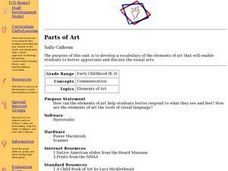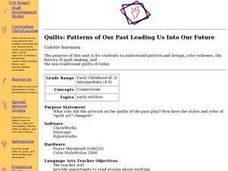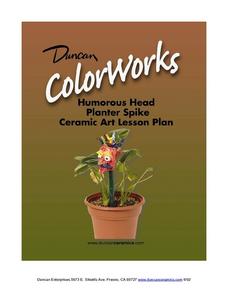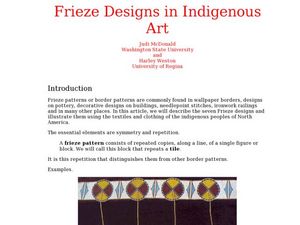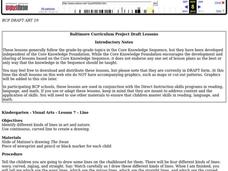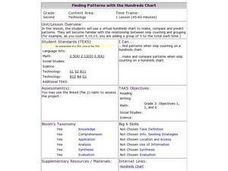Big Kid Science
Create Dynamic Art Using the Eclipse!
What happens to light as it passes through a hole? This is the main question centered around the designing of a solar eclipse dynamic art piece that uses a solar eclipse and paper to create a pinhole projection of the art.
Curated OER
Ocean Exploration: Shapes and Patterns Under the Sea
So many shapes in our vast oceans. Young explorers can discover new shapes in a variety of ways in this lesson. One way is having free exploration with a pattern shape kit handed out by the teacher. Another is by viewing a...
Curated OER
If Paintings Could Talk: Art and Language
Middle schoolers learn about the artist Canaletto, play a vocabulary game, and create a landscape using collage technique. Background information on the artist is provided along with instructions for the game and vocabulary words to...
PBS
Women's History: Glass Windows; Glass Ceilings
Discover stories about women's history in beautiful stained glass windows. The second in a three-part series teaches scholars about a famous artistic style of stained glass windows and the influential women that used art to impact...
Curated OER
Identifying Structured Patterns in Folk Tales
Students are introduced to the structure of folk tales. After working through an example, they identify as many folk tales as possible that follow the same pattern. In groups, they compare a folk tale and a fairy tale to identify the...
Curated OER
Work Patterned on Mondrian
Students study and describe aesthetic properties in art. They use criteria to participate in critiques.
Curated OER
Parts of Art
Young scholars define and use new vocabulary associated with the elements of art. As a class, they brainstorm different ways in which we communicate with one another. In groups, they view different pieces of art from the Native American...
Curated OER
Quilts: Patterns of Our Past Leading Us Into Our Future
Young scholars examine the history of quilt making. They explore the pattern, designs, and color schemes of the quilt. Students read stories about quilting. They create a story to further develop into a story quilt. Additional cross...
Curated OER
Pastel Scratch Portrait
A great cross-curricular project for any art classroom, this activity encourages young artists to consider color, pattern, texture, shape and line in their depiction of a historical figure. After researching a historical figure of their...
Curated OER
Humourous Head Planter Spike: Ceramics Lesson
What a great activity. Kids create humorous ceramic character (heads) spikes to enliven a planter. Modern art is full of expressive and exaggerated forms and your class gets to create them out of clay. This would be a lovely activity to...
Curated OER
The Art and Culture of the Afro-American
Your high schoolers will examine the community in which they live and discuss with the class. Using the Internet, they identify the importance of African-American art and how it relates to the African-American culture. Individually, they...
Curated OER
Art and Culture
Learners compare and contrast the ways in which human figures are portrayed in rock art made by ancient Native American artists and in the drawings and paintings of historic European and American artists. They use images to identify...
Curated OER
Frieze Design in Indigenous Art
Students describe Frieze designs using the work of indigenous people. In this math lesson, students create 7 frieze designs using different patterns. They create one row of repeated art and repeat this 7 times over...
Curated OER
Learning Empathy Through Art
Students create poems based on the Haiku form and research about WWII. Class discussion and classroom readings of student work finish this lesson. Emphasis is placed on Standards in the Arts.
Curated OER
Visual Arts
Students identify different kinds of lines in art and nature. They use continuous, curved line to create a drawing.
Curated OER
Arts Impact and Math
Third graders incorporate math into dancing. In this algebra lesson plan, 3rd graders identify different shapes and patterns using dance movements. They relate the different creations to polygons as they incorporate the use of stretchy...
Curated OER
Sponge Painting
Sponge painting is a technique that is fun for learners of all ages and it can be adapted to fit a variety of skill levels and subjects. Here, little ones use sponges and paint to make geometric patterns. Tip: Sponges can be cut into...
Curated OER
The Art and Science of Impressionist Color
Discover Impressionist painting as students investigate the 19th century combinations of colors characteristically used. Students experiment with their own paintings, utilizing primary and secondary colors.
Curated OER
Patterns: A Stitch in Time
Learners recognize shapes, designs and numbers that form patterns. Using their surroundings, they identify common patterns. They create their own patterns in various software programs and share them with the class.
Curated OER
Shapes and Patterns- Kaleidoscope
Third graders create art using shapes. In this shapes and patterns lesson, 3rd graders explore multiple ways of combining shapes to create new objects and art.
Curated OER
Finding Patterns with the Hundreds Chart
Students review their numbers up to one hundred. Using a chart, they compare and predict patterns that might be in the numbers. They practice skip counting and grouping numbers. Using a spreadsheet, they graph different sets of numbers...
Curated OER
Tissue Paper Butterfly
Creating butterfly art is as simple as 1-2-3. Kids cut coffee filters into butterfly shapes. Next, they wet and place squares of tissue paper onto the filters. Fifteen minutes later, they lift the tissue to reveal a colorful pattern...
Curated OER
My Arkansas Family Tree
Here is a two-part lesson that introduces learners to genealogy by having them create family trees, and map the movements of their ancestors. While this resource is designed for kids who live in Arkansas, it certainly can be adapted for...
Student Achievement Partners
Jacob and Wilhelm Grimm - "The Fisherman and his Wife"
Help young readers learn to read and interpret complex text independently. Teach young children to ask interpretive questions and use the text itself to answer them. Use art, word play and drama to provide a deeper understanding of...






